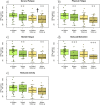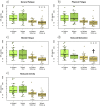Central nervous system biomarkers GFAp and NfL associate with post-acute cognitive impairment and fatigue following critical COVID-19
- PMID: 37573366
- PMCID: PMC10423244
- DOI: 10.1038/s41598-023-39698-y
Central nervous system biomarkers GFAp and NfL associate with post-acute cognitive impairment and fatigue following critical COVID-19
Abstract
A high proportion of patients with coronavirus disease 2019 (COVID-19) experience post-acute COVID-19, including neuropsychiatric symptoms. Objective signs of central nervous system (CNS) damage can be investigated using CNS biomarkers such as glial fibrillary acidic protein (GFAp), neurofilament light chain (NfL) and total tau (t-tau). We have examined whether CNS biomarkers can predict fatigue and cognitive impairment 3-6 months after discharge from the intensive care unit (ICU) in critically ill COVID-19 patients. Fifty-seven COVID-19 patients admitted to the ICU were included with analysis of CNS biomarkers in blood at the ICU and at follow up. Cognitive dysfunction and fatigue were assessed with the Montreal Cognitive Assessment (MoCA) and the Multidimensional Fatigue inventory (MFI-20). Elevated GFAp at follow-up 3-6 months after ICU discharge was associated to the development of mild cognitive dysfunction (p = 0.01), especially in women (p = 0.005). Patients who experienced different dimensions of fatigue at follow-up had significantly lower GFAp in both the ICU and at follow-up, specifically in general fatigue (p = 0.009), physical fatigue (p = 0.004), mental fatigue (p = 0.001), and reduced motivation (p = 0.001). Women showed a more pronounced decrease in GFAp compared to men, except for in mental fatigue where men showed a more pronounced GFAp decrease compared to women. NfL concentration at follow-up was lower in patients who experienced reduced motivation (p = 0.004). Our findings suggest that GFAp and NfL are associated with neuropsychiatric outcome after critical COVID-19.Trial registration The study was registered à priori (clinicaltrials.gov: NCT04316884 registered on 2020-03-13 and NCT04474249 registered on 2020-06-29).
© 2023. Springer Nature Limited.
Conflict of interest statement
HZ has served at scientific advisory boards and/or as a consultant for Abbvie, Alector, ALZPath, Annexon, Apellis, Artery Therapeutics, AZTherapies, CogRx, Denali, Eisai, Nervgen, Novo Nordisk, Passage Bio, Pinteon Therapeutics, Red Abbey Labs, reMYND, Roche, Samumed, Siemens Healthineers, Triplet Therapeutics, and Wave, has given lectures in symposia sponsored by Cellectricon, Fujirebio, Alzecure, Biogen, and Roche, and is a co-founder of Brain Biomarker Solutions in Gothenburg AB (BBS), which is a part of the GU Ventures Incubator Program (outside submitted work). All the other authors declare they have no conflicts of interest.
Figures








References
-
- Frithiof R, Rostami E, Kumlien E, Virhammar J, Fallmar D, Hultstrom M, Lipcsey M, Ashton N, Blennow K, Zetterberg H, et al. Critical illness polyneuropathy, myopathy and neuronal biomarkers in COVID-19 patients: A prospective study. Clin. Neurophysiol. 2021;132(7):1733–1740. doi: 10.1016/j.clinph.2021.03.016. - DOI - PMC - PubMed
Publication types
MeSH terms
Substances
Associated data
LinkOut - more resources
Full Text Sources
Medical
Miscellaneous

